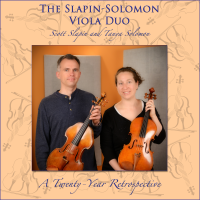Review by Colin Clarke
THE SLAPIN-SOLOMON VIOLA DUO: A 20-YEAR RETROSPECTIVE • Scott Slapin, Tanya Solomon (va) • VIOLACENTRIC no catalog number (89:06) Reviewed from an MP3 download: 320 Kbps
SLAPIN Nocturne. Prelude. Violacentrism: Overture. Ballade. Sonatina. Fanfare. Sonata in C: First movement. TCHAIKOVSKY (arr. Slapin/Solomon) 1812 Overture, op. 49. RIMELIS A Day in Acadia: Midnight at El Sido's. 3 Poems by Rumi: Out Beyond Ideas. Cuban Delights: Maduros. BRUNI Sonata No. 1. PROTO Sonata for Two Violas: Allegro. BUSBY Doppelgänger—You’re It. NEHER Canons and Dances. ROLLA Duet in E♭: Andante moderato. RACHEL MATTHEWS Double Helix: Second movement. WAGNER (arr. Slapin/Solomon) Die Walküre: Walkürenritt.
This is at once a celebration of a viola duo, and a celebration of the viola itself. Drawing from over 10 of the 20 albums this duo has released over the course of two decades (for a plethora of labels), this 90-minute selection of music is something of a thought reprogramming exercise for the listener of what he or she thought was possible from two violas.
There is something tremendously touching, even lachrymose, about Scott Slapin’s Prelude. It is the perfect lead-in to this album, and a perfect miniature in and of itself, speaking of vast open spaces in its language (indebted surely to that of Americana), themselves leading to an active central section which celebrates the resonant lower register of the viola against a driving rhythm above. The performance is confident, not just technically but in the sense that here are two players who clearly act as one; the performance is clearly the fruit of long collaboration. David Rimelis’s “Midnight at El Sido’s” (from A Day in Acadia) seems a logical extension, full of exuberant dance, with the violas now morphing into lower-pitched Bluegrass fiddles.
We then move back in time to the Viola Sonatas by Antonio Bartolomeo Bruni (1756—1821), and with that to a new-found world of eloquence. The sonata needs two absolutely equal voices, and that is precisely what it receives here. The program separates the first movement from the balance, enabling the former to act as something of an anchor. The second movement is gentle and polite, with tender, dropping cadential figures. A set of variations is particularly skillfully drawn, both compositionally and performatively.
It is good to have a fair amount of Slapin’s own music here: his pieces pepper the album. His Nocturne for two violas is expressive, with a long-breathed melody in one instrument (delivered with perfect legato) heard against pizzicato in the other. There is more than a hint of longing and emotional pain to this nocturne—dreams, but unfulfilled ones. Slapin’s Ballade is heartfelt, and given in a resolute, yet variegated performance. The at times overlapping registers between the players attest to their almost telepathic link. The third movement of Slapin’s Sonatina is decidedly haunting, and performed with a sort of extra-temporal sense of suspended time. I also enjoyed the angularity of Slapin’s Fanfare, with its remarkable and inventive use of pizzicato. The first movement of his Sonata in C for Two Violas (structured as Allegro—Moderato—Allegro) is brilliantly written, and fascinating in its combination of unpredictability (more on the structural level, via juxtaposition) and rigor (on the more micro-level). There is a real lyricism to some of the writing, too, that is beautifully conveyed here.
One of the finest pieces on the disc is the second movement (of four) from Frank Proto’s Sonata for Two Violas (2005). Astringent, vital, and charged with tensile energy, it appears here in a performance of huge power. The dedication of the players is never in doubt, and the absolute equality of voices is everywhere apparent. The piece is superb and can be heard complete on the composer’s own website. Its vital energy is balanced by the more reflective overture to Violacentrism by Slapin. It might be heard on only two violas, but the intent is without doubt symphonic in nature, and somehow the players capture not only that but make the moments of held-breath pianissimos really count.
It's fascinating to hear a piece by Gerald Busby, a Texan by birth who began his career by performing Beethoven’s Piano Concerto No. 3 at the age of 17 with the Houston Symphony. His Doppelgänger—You’re It is a musical game of catch-me-if-you-can, light as a feather and fully in the spirit of game play. That fundamental equivalence between Slapin and Solomon really comes out in force here. More restrained, and poignant, is Patrick Neher’s Canons and Dances (wherein the effectiveness of the recorded spatial separation of the players really kicks in), a piece which moves to a dizzying conclusion. (The motives are often circular in construction, underlining this sense of discombobulation.) An extended piece, it is considerably more complex than its title might imply.
We certainly change geographical reason unmistakably for David Rimelis’s “Out Beyond Ideas” from that composer’s Three Poems by Rumi. An almost Arabian slant emerges before a more Classically-oriented, somewhat Mozartian Duet by Rolla takes us back a century or so. The astonishing thing is how equally at home the Slapin-Solomon duo appears in any given type of repertoire. Composer Rachel Matthews is Seattle-based and a graduate of Oberlin. The second movement of her Double Helix makes me want to hear more of her music: It is subtly complex and so strongly composed that it came as a surprise that this will be her first Fanfare Archive entry. The piece has a fine awareness of the sonorous abilities of the viola, as well as its registral scope. It also happens to be notably beautiful.
There are a few surprised here. What on earth is the 1812 Overture doing here? The opening of the excerpt tells us the answer: the hymnic string melody is perfect for violas who can double-stop well (as here). The two players really ratchet up the intensity in a way one might not have considered possible; the sound becomes almost symphonic. Both players excel (there is a fair amount of pass-the-parcel melody to demonstrate their equivalence). The arrangement is masterly and infinitely clever, and the performance drips with character. I will be honest: When I saw this in black-and-white, I simply thought it would never work. It does, and the explosion of virtuosity and pure excitement towards the end is visceral indeed ( there’s a nice use of expressive portamento in that build-up, too). I also like, much to my surprise, Wagner’s “Walkürenritt” (“Ride of the Valkyries” to most people) on two violas. The arrangement is ingenious, and the playing is of a ferocious virtuosity. What a way to end!
Incidentally, for all those viola players reading this (the majority of readers of this review, presumably), the Solomon-Slapin Duo offers a selection of videos on viola technique at YouTube for free. Recording dates for the present release span two decades, and yet the sound is consistently excellent. There is so much to enjoy here, but so much to learn, too, from fresh composers to an appreciation of the expressive abilities of the viola itself. Recommended with enthusiasm. Colin Clarke






















